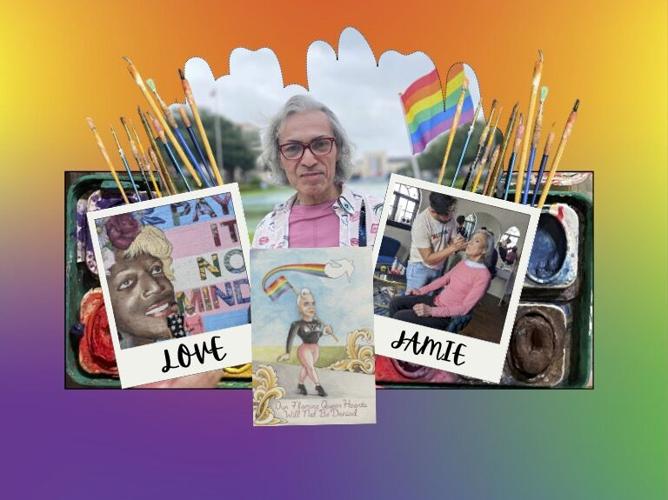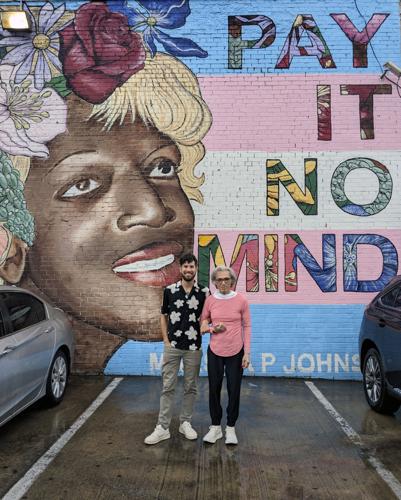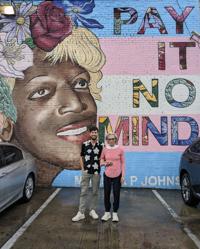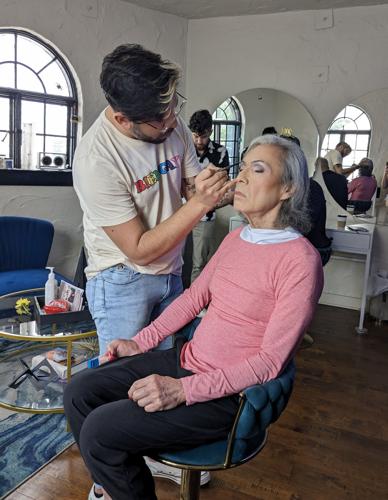
Jamie Diaz waves a rainbow flag at her first pride parade in the top photo, surrounded by her paint, DIY paint brushes, artwork and photos of her and Gabriel Joffe, her longtime friend. (Collage by Gisselle Palomera)
After serving nearly 30 years of a life sentence in prison, Jamie Diaz is finally free. She celebrated by attending her first Pride parade alongside her longtime penpal.
Diaz, known as ‘Auntie Jamie,’ began her gender transition in prison after meeting Gabriel Joffe, a former volunteer at an organization whose mission is to abolish prison systems. Joffe, who is nonbinary and uses they/them pronouns, became her penpal when they came across her letters and art. During that time, Joffe was also beginning their gender transition.
“Despite my advanced age, the hormones are working and I’m starting to see amazing results,” said Diaz in a letter to Joffe. “I’m even starting to tell people that I’m all woman and I even believe it. I’m all me and I’m happy,” reflects Diaz in the award-winning short documentary film that recently premiered on PBS about her life and struggles.
Diaz, now 66 years old, began her gender transition while serving her life sentence in a men’s prison in Texas. Simultaneously, she embarked on her journey into creating the largest body of LGBTQ+ art she could imagine.
“We stumbled upon this alley that had murals of Marsha P. Johnson and Sylvia Rivera,” said Joffe. “Seeing her stand in front of them, and seeing all three of them, kind of reminded me of what pride is all about.”

Jamie Diaz, right, and Gabriel Joffe in Dallas, TX (Amelia Spinney/Courtesy of Greene Fort Productions, LLC)
Diaz is part of the very small population of transgender adults who make it to a later age and become trans elders. There isn’t much academic research on older trans adults, because age ranges in most studies only span ages 16 to 65 and because trans elders rarely beat the odds against suicide, homicide and life-shortening factors.
One study by The Amsterdam Gender Clinic, which has been providing gender-affirming surgeries since 1972, points out that only 11% of transmasculine patients (who were assigned female at birth), and 16% of transfeminine patients (who were assigned male at birth), made it to a later age in life as trans adults by 2015.
Another study on the physical and mental well-being of older trans adults points out that most trans adults “are at significantly higher risk of poor physical health, disability, depressive symptomatology, and perceived stress compared to non-transgender participants” later in life.

"Love, Jamie" Still 3 Letter from Jamie Diaz Courtesy of American Masters.
Andrew Fredericks, the producer and director of photography for “Love, Jamie,” says he is in disbelief that Diaz not only found art as an outlet, but also dedicated that art to declaring love, hope and acceptance. She did it in a way that wasn’t angry or resentful. Directed by Karla Murthy, the documentary features Diaz’ journey of serving a life sentence in a men’s prison.
“What moves me most about Jamie is her resiliency and ability to not only survive, but thrive in a place that’s so de-humanizing,” said Fredericks. “Being incarcerated is designed to break you and take your dignity, but Jamie didn’t allow that to happen.”
In the film, Joffe explains that Diaz had to spend time in solitary confinement because she was experiencing violence and harassment.
An investigation by NBC News in 2020, found that “out of 4,890 transgender state prisoners tracked in 45 states and Washington, D.C., NBC News was able to confirm only 15 cases in which a prisoner was housed according to their lived gender, based on responses to Freedom of Information Act requests over the past year.”
“Sometimes I lay in the dark and I feel it closing in on me,” said Diaz in the short doc, about her struggles in prison. “But when I turn on the light, I relax a little bit. Breathe better.”
She makes art filled with messages of hope and liberation. Diaz uses images of queer and nonbinary people painted in bright watercolors with messages of freedom, using birds and skies painted in pastel tones and rainbows.
At first, Diaz used the basic watercolor paint palettes from the commissary – the ones that come with a cheap little bristle brush.
Then, Diaz began to make her own brushes using real hair she got from people she met inside.

Jamie Diaz in makeup chair at Glam Haus Collective (Amelia Spinney/Courtesy of Greene Fort Productions, LLC)
“You wouldn’t believe all the things I think about when I’m working on my art,” says Diaz at the start of the short doc. “I go all over the world in my mind. Sometimes I think I even go to other worlds.”
Diaz was set for parole in May 2025, but suffered a stroke in January that impacted her mobility, dexterity and communication. Due to her medical condition and recovery, she was granted parole earlier than expected.
Diaz is recovering and hopes to create larger-scale, oil-based paintings when she makes more progress on her recovery.
“I want people to feel love and understanding when they see my art,” said Diaz in the documentary.
“Love, Jamie” premiered on June 3rd on PBS, as part of the first American Masters Shorts Series and is available to watch for free. This new series features documentary shorts about artists like Diaz, who are creating outstanding work and pushing boundaries.
For more information on Jamie or get an update on her condition, visit her art website at jamiediazart.com.

















(0) comments
Welcome to the discussion.
Log In
Keep it Clean. Please avoid obscene, vulgar, lewd, racist or sexually-oriented language.
PLEASE TURN OFF YOUR CAPS LOCK.
Don't Threaten. Threats of harming another person will not be tolerated.
Be Truthful. Don't knowingly lie about anyone or anything.
Be Nice. No racism, sexism or any sort of -ism that is degrading to another person.
Be Proactive. Use the 'Report' link on each comment to let us know of abusive posts.
Share with Us. We'd love to hear eyewitness accounts, the history behind an article.